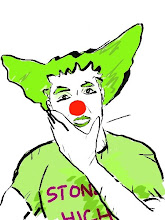Lesson 12, 11_26_2007
第十二節 偶動畫(Puppet Animation)
以下是一篇1996年2月偶動畫大師Brother Quay(奎爾兄弟) (圖一)接受紐約影評協會作家Ryan Deussing的專訪,在1995年Brother Quay拍攝了一部由真人演出的影片:Institute Benjamenta(中文翻譯為:夢遊班傑明),同時在片中結合他們所擅長的偶動畫,整部影片依然充斥著他們兄弟倆之前偶動畫短片中一貫地神祕超寫實氣氛,在Ryan Deussing的訪問中,兩人對他們的偶動畫創作歷程作了非常詳盡的說明。
同時在這篇專訪中,我們也可以了解一些所謂「藝術電影」的作者如何由文化層面接觸到個人內心的深沉思索,Brother Quay為何選擇人偶來代替真人的表演?藉由人偶擬真的詭祕氣氛,再加上他們精心設計的場景、音樂,營造出令人窒息的夢境。
請點選「夢遊班傑明」的片段,雖不是偶動畫,但是非常的怪異
圖一,偶動畫大師:奎爾兄弟(Brothers Quay)

以下是一段Brother Quay的偶動畫,Stille Nacht V - Dog Door。(Still Nacht是德文Silent night的意思,翻譯成中文是:平安夜第五篇→狗洞)
1984年Brother Quay的成名作,「The Cabinet of Jan Svankmajer」以知名捷克動畫大師Jan Svankmajer為名的14分鐘鉅作,至於Jan Svankmajer的偶動畫與真人偶動畫有多神,我在本章最後會貼上兩段他的影片。
短片研究:The Cabinet of Jan Svankmajer(我原本想貼上原片,但是youtube上的影片連結已經不見了,但是我找到了2006他們兩兄弟的專訪,和我以下的專訪其實蠻類似的,而且有許多新的說明內容,請各位同學參考,他們講話的部分不要跳過,因為會穿插一些動畫製作過程的片段)
Brother Quay訪談:
Author: Ryan Deussing ---
Date: 02/09/96 ---
Copyright: ThingReviews
NYC Film Forum
中文翻譯:Wesley Chen
Ryan Deussing:
You both went to Art School--first in Philadelphia and then in England--and wound up working as animators. Is that what you planned on all along?
訪問者Ryan Deussing:你們兄弟兩位原本是在費城和倫敦就讀美術學校,但現在卻成為動畫家,這一切都是在你們的原有的生涯規劃之中嗎?
Brothers Quay: We started off as illustrators, drawers, and it was because we became frustrated by the stillness of that image, the lack of sound, of depth, of music, we figured there had to be another way to go. We managed in school to do some 2D, cut-out animation shorts, but we were frustrated by that as well--we wanted the third dimension.
受訪者Brothers Quay:我們剛開始是想成為插畫家或是畫家,但是漸漸對於這類純繪畫表現方式的特性感到十分無力,尤其是只有靜止的影像、沒有聲音與音樂的配合、視覺的深度欠缺等方面;因此我們決定嘗試另一種創作型態來表現我們的藝術理念,在學校時嘗試了一些2D和拼貼(cut-out)類型的動畫短片,但是在試了2D之後那種無力感依然存在,於是,我們想再向前一步,投入3D動畫的創作領域。
RD: Had you begun to experiment with animation before you arrived in London?
Ryan Deussing:你們到倫敦就學之前就嚐試了各類動畫的實驗嗎?
BQ: No, we came to animation at about the age of thirty-two. At least puppet animation, the kind of work we've become known for.
Brothers Quay: 不,我們在32歲的時候才開始真正玩動畫,應該是說「偶動畫」(Puppet Animation),這一種動畫才真正使我們闖出了名號。
RD: What draws you to the literary sources which serve as inspiration for your films? They all seem to be drawn from the eastern European/Germanic vein, such as ?don von Horv?rth, from whom the title TALES FROM THE VIENNA WOODS is borrowed, or Bruno Schultz, whose writings were your starting point for STREET OF CROCODILES, and of course Robert Walser, whose novel JAKOB VON GUNTEN inspired your lates film, INSTITUTE BENJAMENTA.
Ryan Deussing: 你們是如何挑選出一些文學素材來激發出你們作品的創作靈感,尤其是這些題材似乎都蘊含著東歐及日耳曼民族文學風味的元素,如你們的動畫短片「TALES FROM THE VIENNA WOODS 」片名就是取材自Odon von Horvarth(圖二)的一部劇本名稱 (二次大戰奧地利名劇作家1901-1938,一生非常恐懼打雷,在37歲時死於一廠在暴風雨中被樹枝擊中的意外), 另外還有Bruno Schultz (波蘭籍猶太裔小說家、畫家1892-1942,被認為是20世紀最偉大的波蘭散文作家,死於二次大戰德國秘密警察槍下) 的小說情節內容也被用於動畫短片「STREET OF CROCODILES」的開頭,當然還有Robert Walser (圖三) (德國現代主義小說家、詩人1878-1956,擅用荒誕語言來營造:浪漫主義、哲理、詼諧,他有嚴重的精神分裂症,1929年後幾乎都在療養院度過,在一場大雪後的清晨他外出散步,死於心臟病突發,他倒臥於雪中的型態,正如他寫的第一本小說主人翁死亡的場景一模一樣) 對你們最新的作品Institute Benjamenta的創作發想也有著明顯的痕跡。
以下是Brother Quay的偶動畫短片,平安夜第三篇:「Tales from the Vienna Woods」請按此點選
圖二,奧地利劇作家Odon von Horvarth 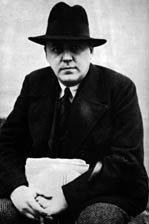
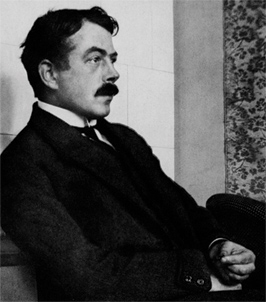 圖三,上圖為德國小說家Robert Walser
圖三,上圖為德國小說家Robert Walser
BQ: For one the whole universe of the puppet is an eastern European artform, one which really doesn't exist in America, and once we became aware of the region in which European puppetry was developed and refined, we were attracted to the literature which surrounded it. This process led us of course to central European literature and music, although that's not to say it's our only obsession. But the real turning point for us was coming across the diaries of Franz Kafka, because what he left out of the stories, we found in his diary: these half-fragments, things that were unbelievably evocative, so that Kafka really led us in to central Europe. And of course Kafka adored Walser's writing.
Brothers Quay: 眾所皆知「人偶」表演本來就是東歐所特有藝術模式,這些原本在美國是不存在的表現方式,當我們明瞭東歐地區對與人偶表演藝術的建立、發展和創新的成就之後,自然而然地我們也開始被環繞於這個地區的文藝創作所吸引。在這個過程中我們熱中於歐洲的文學、音樂,雖然還稱不上是沉溺迷戀,而真正的轉戾點是當我們讀了Franz Kafka (圖四) (卡夫卡,捷克籍猶太裔德語小說家1883-1924,擅以寓言方式來敘事,41歲死於肺癆,死後小說、日記、書信被整理出版,世人驚艷) 的日記之後;因為他的日記裡包含了許多故事片段,還有許多令人難以想像且具有啟發性的事情,所以是卡夫卡引領我們真正專注在歐洲文藝,而你也知道,卡夫卡是非常崇拜Robert Walser作品的。
圖四,卡夫卡流傳最廣的官方相片
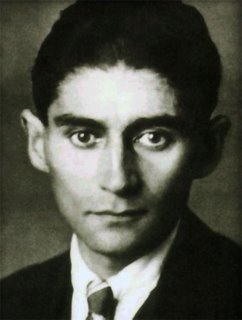
RD: Your films are also reminiscent of early German silent cinema. Is it safe to assume that German Expressionist and Weimar film has had a big influence on your style?
Ryan Deussing:你們的作品同樣的顯示出早期德國的無聲電影,我們是否可以由此推斷德國的表現主義藝術家與「威瑪電影」 (1918-1933年德國共和時期的電影製作風格,極具表現主義風格) 也對你們的風格有著巨大的影響?
註:表現主義expressionism:表現主義是20是祭出流行於德、法、奧、北歐、俄的文學藝術流派。表現主義為了表明藝術家的情感而歪曲現實,這個做法尤其用來表達恐懼的情感。
BQ: I know why people are prone to say that, because our animation draws heavily on a very sophisticated visual language--a certain quality of lighting and decor, of stylized movement--which has a lot to do with Expressionism. But at the same time one could talk Keaton, or early Swedish or Danish cinema, all of which are crucial for us. The essential influence is that of a visual aesthetic which doesn't rely upon dialogue.
Brothers Quay:我們了解為什麼大家都這麼認為,因為在我們的偶動畫作品中,呈現了很多沉重而且複雜的視覺語言:包含了非常多層次的的燈光設計和佈景裝飾以及獨特的人偶和鏡頭運動,這些都是頗富表現主義風格的。但同時我們也可以聯想到Keaton (在此應該是指Buster Keaton,1895-1966,美國著名無聲電影喜劇演員以及製片家) ,或是早期瑞典和丹麥的電影,總之所有的因素對我們都是很關鍵的,這種重要的影響要點其實重點就在視覺美學的意像不需要依賴對白來輔助。
RD: This aesthetic seems to me to be a sort of "stylized Germania", for lack of a better term, which reminded me immediately of Guy Maddin's CAREFUL.
Ryan Deussing:這種美學對我們而言似乎是一種風格式的德國風 (訪問者意指有極強烈的表現主義風格) ,但是有難以有準確的詞彙可以形容,對我個人而言倒是立刻聯想到Guy Maddin (圖五) 的電影「Careful」 (圖六) 。
以下這是一段Guy Maddin的電影Careful的片段,Brothers Quay的創作風格在某些方面,被認為和Guy Maddin非常相似,在下一句的回答中,他們兩兄弟有提到這件事。
圖五,加拿大籍導演Guy Maddin,他的作品風格是充斥了大量的表現主義符號與心理暗示

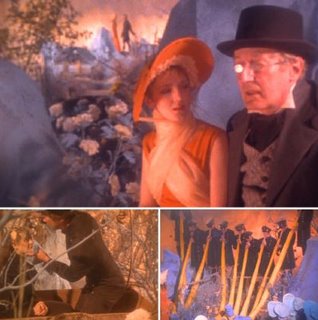 圖六,Maddin的作品Ccareful劇照
圖六,Maddin的作品Ccareful劇照
BQ: Well Walser's book, which was our foundation, is actually not an expressionist work, it has nothing to do with it, and the relation to CAREFUL is purely fortuitous. We had never seen the film when we got started shooting, and he had never read the book. Somehow we do share the same iconography, however. We know Guy and have written each other various letters, but he's got a sense of humor compared to us.
Brothers Quay:嗯,Walser的小說是我們創作的基礎(指影片Institute Benjamenta),實在算不上是一種表現主義的作品,連一點邊都沾不上,要說和Careful這部電影的關連性其實也純粹是一種巧合,我們在拍Institute Benjamenta的時候從未看過Careful這部電影和書,但是兩部片子的確是有著共同的代表圖像,反正我們也認識Guy Maddin,彼此之間常常通信,他對於和我們之間的各種比較倒是抱著一種幽默的心態來看待。
RD: You mentioned music as another thing you culled from central Europe. It plays a big role in all of your animation, and BENJAMENTA is no exception. Do you begin working with a score already at hand?
Ryan Deussing:你們也提到音樂也是另一個你們取材自歐洲的元素,音樂在你們所有的偶動畫影片中扮演了重要的角色,當然Institute Benjamenta也不例外,你們是先有了音樂再按照節奏來拍攝你們的動畫嗎?
BQ: Absolutely. Only once in our life have we had the music done in post-production, for a commercial. We rely on music to propose certain things we would have never foreseen. For us music is the bloodstream and like any choreographer we compose our visual narrative through music--it almost co-writes the scenario. We'd like to achieve a musicalization of space, and would prefer our work to follow musical law rather than a dramaturgical one.
Brothers Quay:當然是如此,我們創作以來只有一次是事後才作曲的,那次是拍廣告。我們相當倚賴音樂來計畫或是追尋一些難以「預視」的想法,對我們而言,音樂就是整個創作的血脈,就像編舞家一樣,我們也是以音樂來編排我們的「視覺故事」,視覺元素與音樂元素基本上共同地建構出我們的動畫世界。同時我們的作品也比較習慣跟著音樂的規律鋪陳,而比較不會按照戲劇的規律,我們非常想要達成一個音樂化空間的境界。
RD: You've described your move from stop-motion animation to live action filmmaking as analogous to a composer moving from chamber pieces to a symphony.
Ryan Deussing:你們曾經描述你們從「停格動畫」到寫實片的拍攝,就像是從一個室內樂作曲家轉變成交響樂作曲家一樣。
BQ: Well it was a giant step for us, but we felt we were quite ready. I mean Christ, we're fourty-eight years old. Bertolucci shot his first feature when he was twenty-one or so, which makes us appear slightly retarded. In a sense we've got to make up for lost time.
Brothers Quay:哈哈,其實對我們而言拍寫實片是一個很大的突破,但是我們認為已經準備好了,我的意思是:天哪,我倆都已經48歲啦,貝托路齊 (義大利名導演,曾執導1987末代皇帝the Last Emperor) 在21歲的時候就拍了他的第一部寫實劇情片,跟他比起來,我們看來實在是有點白痴,所以現在要抓緊時間來趕上嘍。
RD: What is it about the term "surreal" that you object to, when used in reference to your films?
Ryan Deussing: 「超寫實」這個描述如果用在你們的作品介紹上,你們作何感想?
BQ: Our fear is that the term is mis-used. Of course we are familiar with surrealism, we know its history and its place, but the term can too often be used in a cavalier way, without acknowledgement of its real meaning. Like, "Oh, that's cool, that's surreal." When it's used cautiously and intelligently it can be a very descriptive term, but we're weary of it's over-use. At this rate every housewife is a surrealist.
Brothers Quay:我們所擔心的是:超寫實這個名詞常被誤用,我們當然對於超現實主義頗有了解,對於它的歷史、淵源都不陌生,但是這個詞實在被濫用了,人們從來不曾深刻思考它的深層意涵,就像是常聽到人說:哇!那是超寫實的,真酷!當超寫實被謹慎而且明智地運用時,它的確是一個非常具有清楚描述性的語句(對我們的作品而言),但是我們真的非常厭倦它的濫用,像是有人曾這麼說著:「每一個家庭主婦都是超現實主義者!」真是夠了。
RD: You've said that you are "Europeans by choice", although you were born in Philadelphia. Do you think it would be possible for you to make your kind of films in America?
Ryan Deussing:雖然你們出生於美國費城,但你們曾說自己是「選擇做的歐洲人」,你們認為在美國有可能拍出類似兩位作品類型的影片嗎?
BQ: It would be totally impossible for us to have done what we've done in America. American companies might buy our films, but we work on commission, and the European commissioning bodies are much more open and receptive of our ideas. Our puppetry may well be relegated to the perimeter, but at least it's allowed to exist. Channel Four goes so far as to treat animation as an artform and to set aside a whole budget for it's production. Sadly I don't think that could ever happen here.
Brothers Quay:如果我們在美國拍片、生活,今天絕不可能會有這樣的成績。美國的製片公司或許會買下我們的作品,但是我們是以抽成方式來賺取報酬,歐洲的抽成制度比較開放而且尊重我們的創作想法,我們的人偶表演藝術或許在主流電影市場之外,但最少它是被容許存在的,公共電視台(歐洲)對於動畫的態度是:認為它是一種藝術形態,在製作時對於預算的考量並不斤斤計較,但是,我們不認為這樣在美國市場可以行的通。
RD: I was surprised to find that you were participating in the DIGITALE festival last year in Cologne, which focuses on digital media and celebrates computer-aided filmmaking. Your work is very much of the old-school, even if you did use a bit of digital tomfoolery in BENJAMENTA.
Ryan Deussing:我非常的驚訝你們竟然會參加去年在德國科隆所舉辦的「數位故事」展,那是一個著重在數位媒體應用、電腦輔助攝影、後製等技術應用於電影工業的展覽會;你們的東西其實是非常傳統的,雖然你們這次也用了一些些數位技巧在Institute Benjamenta裡。
BQ: Well, the man who runs DIGITALE is a friend of ours, and I think the reason we were included in the program at the last minute was because he's interested in the alchemical quality of our films. We were sort of a counterweight to the rest of the festival, because our films contain a form of combustion that lies right beyond the realm of digital effects. It was as if to say, "You can work wonders with a computer, but can you do this?"
Brothers Quay:嗯,展覽會的主辦人是我們的老友,我們會在最後一分鐘被納入展場節目表的理由是:我們的老朋友對於我們的影片中,在化學沖片後所顯出的古舊晦暗材質氣氛頗有興趣,你知道,我們在展場中類似一種嗆聲效果,就像我們的「傳統」作品擺在一堆由科技所擺弄出來的數位影像王國之中,就如同對它們說:「你們可以用電腦搞出一大堆特效,但是電腦可以搞出這個嗎?」
RD: I'm sure people are always asking you about your decision to work together. It's uncommon for twins to stick by each others side, much less for them to work together in the same field.
Ryan Deussing:我知道大家一定持續的問你們為什麼一直是一起創作,對於雙胞胎而言選擇同樣的工作與創作領域,而且總是不論生活、工作都窩在一起實在有些怪異。
BQ: For us it's invisible, we don't even notice it. You're only reminded that you're a twin when you walk down the street together and people stare at you. Actually, we passed two old women today, identical twins, probably in their seventies, and immediately we thought "Jesus, will we look that bad when we get old?", "Why don't they just part?", and we had to admit that they were slightly freaks. People of course expect us, as well, to eventually part and to become normal people, to have an individual life, but we find that being twins insulates us quite nicely from the demands of reality.
Brothers Quay:對我們而言這個問題實際上是不存在的,我們甚至從未注意到這一點。只有當我們一起走在街上的時候,才會被人們盯著瞧,而且才會被提醒你是雙胞胎這個事實。你知道嗎,今天我們在路上碰見兩個七十多歲的老太太,也是雙胞胎,幾個念頭立刻冒上心頭:「老天!當我們老的時候,看起來也會那麼慘嗎?」「她們兩個幹麼靠的這麼近?」,當時不得不承認我們有點兒被嚇到了。人們當然會希望我們最後應該分開,同時變回「一個」正常人,有著獨立自主的生活;然而,我們也發現,在身為雙胞胎這一點上,的的確確的將我們從許多現實的壓力中隔絕出來,這也不是壞事。
附錄:Jan Svankmajer
1. 1989 Meat Love(肉食者1992)
2. Breakfast(早餐,食物三部曲之一)
